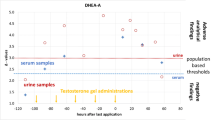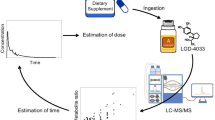Abstract
Progesterone (PROG) is a naturally occurring progestagen, which has been used to prevent preterm birth, control persistent anovulatory bleeding, and treat premenstrual syndrome in clinical practices. Studies on the metabolism of PROG have demonstrated that PROG is the precursor of other steroids such as 5β-pregnane-3α,20α-diol (PD), testosterone (T), and 17-hydroxyprogesterone. PD is the most commonly used endogenous reference compound (ERC) in the isotope ratio mass spectrometry (IRMS) analysis for doping control. It is expected that the PROG administration could affect the carbon isotope ratios (13C/12C, expressed as δ 13C-value) of PD and T metabolites, and lead to the false-negative or false-positive results in doping test. The influences of oral and intramuscular administration of PROG on the urinary steroid profile and carbon isotope ratios of steroids were investigated in this study. It was demonstrated that the urine concentrations and the δ 13C-values of PD were affected obviously. The depleted δ 13C-values of PD could be used to suggest PROG administration. Using PD as ERC may result in the distorted evaluation for suspicious urine sample in IRMS analysis when PROG is ingested. The 5α-androst-16-en-3α-ol and 11β-hydroxyandrosterone could be used as the alternative ERCs in case of PROG administration. The carbon isotope ratios of androsterone (An) and etiocholanolone (Etio), two T metabolites, remained unchanged throughout the excretion study, which suggested that the δ values of An and Etio could still be used as the urinary markers of T administration even when PROG was administrated.


Similar content being viewed by others
References
Wood PJ, Gower DB (2010) In: Makin HLJ, Gower DB (eds) Steroid analysis, 2nd edn. London, Springer
Piper T, Emery C, Saugy M (2011) Recent developments in the use of isotope ratio mass spectrometry in sports drug testing. Anal Bioanal Chem 401:433–447
Bremer AA, Miller WL (2008) The serine phosphorylation hypothesis of polycystic ovary syndrome: a unifying mechanism for hyperandrogenemia and insulin resistance. Fertil Steril 89:1039–1048
da Fonseca EB, Bittar RE, Carvalho MH, Zugaib M (2003) Prophylactic administration of progesterone by vaginal suppository to reduce the incidence of spontaneous preterm birth in women at increased risk: a randomized placebo-controlled double-blind study. Am J Obstet Gynecol 188:419–424
Tita ATN, Rouse DJ (2009) Progesterone for preterm birth prevention: an evolving intervention. Am J Obstet Gynecol 200:219–224
Dennerstein L, Spencer-Gradner C, Gotts G, Brown JB, Smith MA, Burrows GD (1985) Progesterone and the premenstrual syndrome: a double blind crossover trial. Br Med J 290:1617–1621
The State Pharmacopoeia Commission of P R China (2010) Pharmacopoeia of the People’s Republic of China, vol 2, English edn, China Medical Science, Beijing
Bennell K, White S, Crossley K (1999) The oral contraceptive pill: a revolution for sportswomen. Br J Sports Med 33:231–238
Lebrun CM, Petit MA, McKenzie DC, Taunton JE, Prior JC (2003) Decreased maximal aerobic capacity with use of a triphasic oral contraceptive in highly active women: a randomised controlled trial. Br J Sports Med 37:315–320
World Anti-Doping Agency (2013) 2014 Prohibited List, Lausanne. http://www.wada-ama.org/Documents/World_Anti-Doping_Program/WADP-Prohibited-list/2014/WADA-prohibited-list-2014-EN.pdf. Accessed 9 Apr 2014
Whitehead MI, Townsend PT, Gill DK, Collins WP, Campbell S (1980) Absorption and metabolism of oral progesterone. Brit Med J 280:825–827
Stanczyk FZ, Gentzschein E, Ary BA, Kojima T, Ziogas A, Lobo RA (1997) Urinary progesterone and pregnanediol use for monitoring progesterone treatment. J Reprod Med 42:216–222
Lignieres B, Dennerstein L, Backstrom T (1995) Influence of route of administration on progesterone metabolism. Maturitas 21:251–257
Muccio Z, Jackson GP (2009) Isotope ratio mass spectrometry. Analyst 134:213–222
WADA Laboratory Committee (2014) WADA guidelines-detection of synthetic forms of endogenous anabolic androgenic steroids by GC-C-IRMS. Lausanne http://www.wada-ama.org/Documents/Resources/Guidelines/WADA-Guidelines-Detection-by-GC-C-IRMS-v1-2014-EN.pdf. Accessed 12 Jun 2014
Liu X, Zhang Y, Wu M, Zhang C (1999) In: Schänzer W, Geyer H, Gotzmann A, Mareck-Engelke U (ed) Recent advances in doping analysis (7). Sport und Buch Strauss, Köln
Wang J (2008) Application study on detection of steroid doping with IRMS, Doctoral thesis. Beijing Sport University
Wang J, Wu M, Liu X, Xu Y (2011) Profiling of urinary steroids by gas chromatography–mass spectrometry detection and confirmation of androstenedione administration using isotope ratio mass spectrometry. Steroids 76:1560–1565
Cawley AT, George AV (2012) Complementary stable carbon isotope ratio and amount of substance measurements in sports anti-doping. Drug Testing and Analysis 4:897–911
Saudan C, Desmarchelier A, Sottas PE, Mangin P, Saugy M (2005) Urinary marker of oral pregnenolone administration. Steroids 70:179–183
Saudan C, Baume N, Mangin P, Saugy M (2004) Urinary analysis of 16(5α)-androsten-3α-ol by gas chromatography/combustion/isotope ratio mass spectrometry: implications in anti-doping analysis. J Chrom B 810:157–164
Piper T, Schlug C, Mareck U, Schanzer W (2011) Investigations on changes in 13C/12C ratios of endogenous urinary steroids after pregnenolone administration. Drug Test Anal 3:283–290
Cawley AT, Trout GJ, Kazlauskas R, Howea CJ, Georgeb AV (2009) Carbon isotope ratio (δ 13C) values of urinary steroids for doping control in sport. Steroids 74:379–392
Renterghem PV, Eenoo PV, Geyer H, Schänzer W, Delbeke FT (2010) Reference ranges for urinary concentrations and ratios of endogenous steroids, which can be used as markers for steroid misuse, in Caucasian population of athletes. Steroids 75:154–163
Acknowledgments
The authors gratefully acknowledge the financial support from the General Administration of Sport of China (No. 2013B003).
Author information
Authors and Affiliations
Corresponding author
Rights and permissions
About this article
Cite this article
Wang, J., Yang, R., Yang, W. et al. Impact of progesterone administration on doping test of endogenous steroids. Anal Bioanal Chem 406, 6061–6067 (2014). https://doi.org/10.1007/s00216-014-8027-x
Received:
Revised:
Accepted:
Published:
Issue Date:
DOI: https://doi.org/10.1007/s00216-014-8027-x




